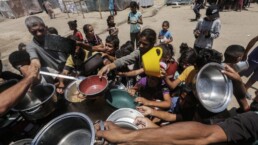The state of hunger in Gaza has not ended. Its long-term health effects are starting to show.
By Tareq S. Hajjaj, Mondoweiss
Ahmad Abdulrahim, 38, strolled the remains of the markets in Gaza City with 150 Shekels in his pocket, the amount of money he used to feed his family of five for a week before the genocide. Today, that amount can hardly buy a single meal.

The markets, now little more than bombed-out remains, are empty of all basic needs, including vegetables, meat, and fruits. For the majority of people, such luxuries are unavailable except at unimaginable prices. Most vegetables, rare though they are, come from people’s gardens.
All Ahmad could find were cleaning supplies and canned foods. Ahmad told Mondoweiss that due to his children’s long-term dependence on these foods, they’ve started to develop health problems. After a protracted search, Ahmad found some zucchini; he walked faster when he noticed the seller, who had placed them in a small pile on the ground on top of a plastic bag. When he asked about the price, he was surprised to know that one kilogram of zucchini cost 80 Shekels ($20). Before the war, it used to be 3 shekels per kilo (less than a dollar).
Such was the price for most other vegetables that could be found. One kilo of green peppers cost 250 shekels ($66), where it used to be 5 ($1.4). One kilo of cucumber and tomato cost 90-100 shekels ($23-$26), which used to be 2-3 shekels (53-80 cents).
Recent Posts
Layoffs in 2025 Second-Highest Since 2009 in Potential Sign of Looming Recession
November 9, 2025
Take Action Now “Those laid off now are finding it harder to quickly secure new roles,” one of the report’s authors said.By Chris Walker,…
With Food Banks in ‘Disaster Response Mode,’ Supreme Court Lets Trump Pause SNAP Funds
November 8, 2025
Take Action Now This is insane,” said US Rep. Pramila Jayapal. “Trump is jumping through hoops to block SNAP.”By Jake Johnson, Common Dreams The…
How Many People Do You Have to Kill to Get a Peace Prize?
November 7, 2025
Take Action Now The Nobel Peace Prize is going to a Venezuelan advocate for deadly sanctions against — and an invasion of — Venezuela.By David…
New York’s Largest ICE Prison Dogged By Allegations Of Shoddy Medical Care
November 6, 2025
Take Action Now “I shouldn’t have lost my fingers,” one detainee said of ICE guards’ failure to get him the care a doctor prescribed.By J. Dale…




